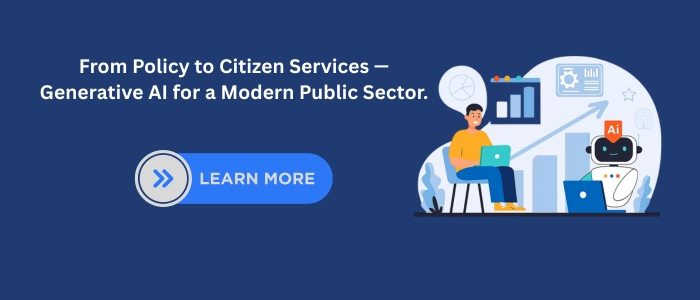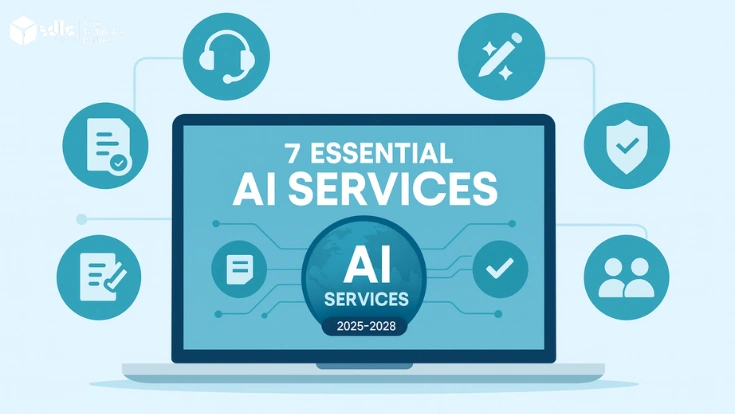Introduction
Governments around the world are searching for ways to deliver services more efficiently, transparently, and equitably. Rising citizen expectations, budget constraints, and complex policy challenges make this no small task. This is where Generative AI in Government comes in.
Generative AI, a branch of artificial intelligence that can create content and simulate outcomes, is already changing industries from healthcare to finance. Its potential in the public sector is equally significant. By streamlining administrative processes, generating insights from data, and supporting evidence-based policies, generative AI offers governments the tools to modernize services and improve decision-making.
This article examines the role of AI for Public Sector services, outlines the Benefits of Generative AI for Government Services, explores the promise of AI-driven Policy Making and Decision Support, and acknowledges the Challenges of AI Adoption in Government.
Role of Generative AI in Government Systems
Government platforms manage data across public services, administration, and policy operations. Generative AI can support these systems by summarising documents, assisting with internal knowledge sharing, and generating drafts for routine communications. Many agencies explore Generative AI development services to build models that align with transparency, accountability, and data-handling requirements.
Where Generative AI Fits in Public Services

Generative AI brings new ways for governments to solve problems, improve operations, and meet citizen needs. Unlike traditional systems that only automate repetitive tasks, generative AI creates responses, drafts documents, and predicts outcomes.
High-Impact Use Cases
Citizen Services: AI chatbots can generate personalized answers to questions about taxes, healthcare, or licenses.
Public Communication: Drafting clear and accessible government messages for emergencies or policy updates.
Data Summaries: Turning complex datasets, such as economic reports or environmental statistics, into citizen-friendly summaries.
Permits and Licensing: Automatically drafting approval documents for officials to review.
Public Health: Analyzing patient data trends and generating alerts for potential outbreaks.
Real Results
A city adopting generative AI for building permits could cut processing time by 50%. A national health agency could use AI-generated insights to detect outbreaks weeks earlier than before.
Benefits of Generative AI for Government Services
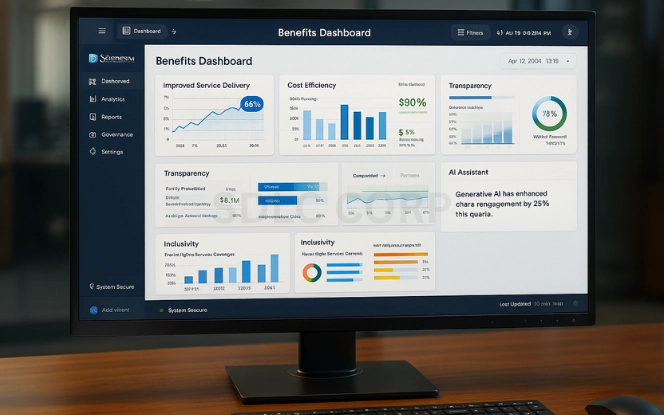
The Benefits of Generative AI for Government Services extend beyond cost savings. They shape how citizens interact with their governments.
- Improved Service Delivery – Faster, clearer, and more consistent responses to citizen needs.
- Cost Efficiency – Reduction of manual work and operational inefficiencies.
- Transparency – AI-generated summaries of budgets and reports that are easy for citizens to understand.
- Smarter Policies – Data-driven models that simulate the effects of proposed laws or regulations.
- Inclusivity – Translation features that improve access for citizens who speak different languages or need accessibility support.
AI-driven Policy Making and Decision Support
Policy development often involves reviewing large volumes of legislation, reports, and stakeholder feedback. Generative AI can help consolidate information, draft summaries, and support scenario analysis. In this context, a Generative AI consulting company may assist government teams in evaluating appropriate use cases, managing risk, and defining governance frameworks for responsible AI use.
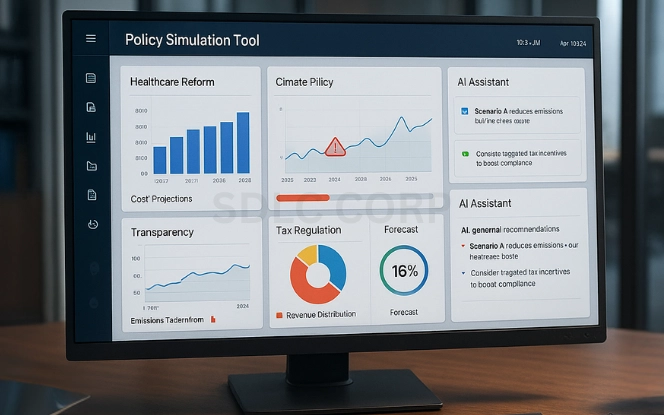
Policy makers often face tight timelines and incomplete data. AI-driven Policy Making and Decision Support can bridge this gap by:
- Summarizing global best practices from thousands of reports.
- Running simulations to forecast the impact of policy options.
- Highlighting risks and trade-offs in real time.
For example, a government evaluating renewable energy policies could use generative AI to model outcomes for emissions, job creation, and long-term costs. Officials then review these AI-generated insights before making a decision.
Artificial Intelligence in Governance
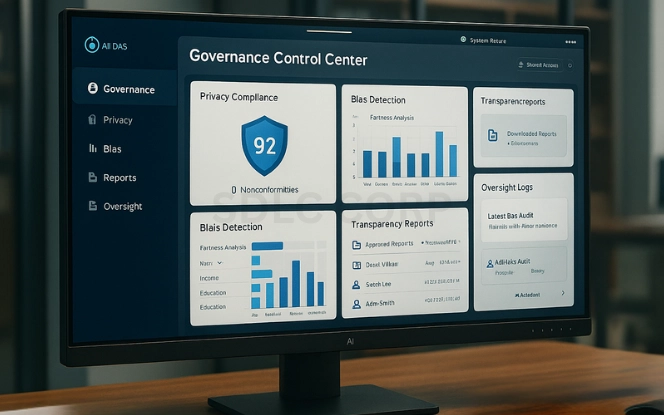
The promise of Artificial Intelligence in Governance is tied closely to ethics and accountability. Governments must ensure that AI systems are fair, transparent, and secure.
Key Considerations
Privacy: Protecting citizen data from misuse or exposure.
Bias: Preventing algorithms from reinforcing discrimination.
Transparency: Making AI processes and decisions explainable.
Oversight: Ensuring human responsibility remains central.
Trust is critical. Citizens need confidence that generative AI supports human decision-making rather than replacing it.
Challenges of AI Adoption in Government
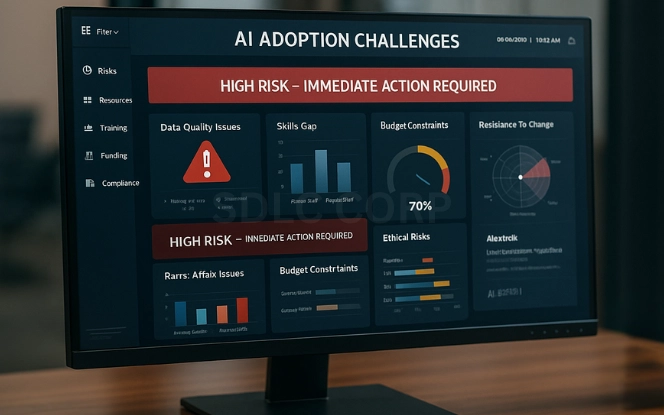
While the potential of AI is clear, the Challenges of AI Adoption in Government must be acknowledged.
- Data Quality – AI relies on accurate and comprehensive data, which is often lacking in government systems.
- Skills Gaps – Many public agencies lack the workforce to implement and manage AI responsibly.
- Budget Constraints – Infrastructure and expertise require investment that may not be prioritized.
- Resistance to Change – Longstanding bureaucratic processes can delay adoption.
- Ethical Risks – Unchecked algorithms may harm the very citizens they are meant to serve.
Implementation Roadmap: From Pilot to Scale
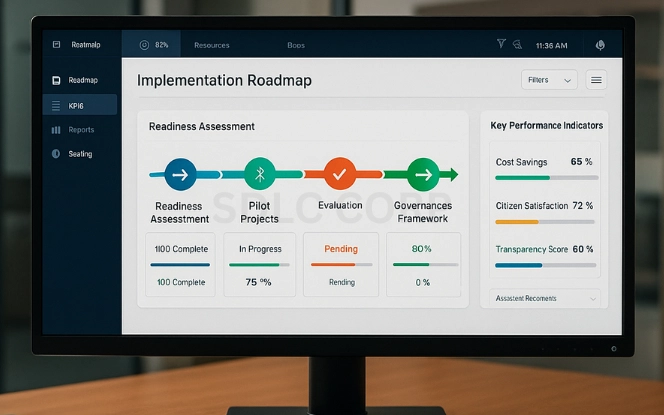
Governments can move from experimentation to large-scale adoption with a clear roadmap:
- Readiness Assessment – Review data quality, legal frameworks, and workforce skills.
- Pilot Projects – Start small in high-impact areas such as citizen services or document drafting.
- Evaluation – Measure cost savings, citizen satisfaction, and transparency improvements.
- Governance Framework – Establish oversight bodies, bias audits, and privacy safeguards.
- Scaling – Expand to other departments while maintaining responsible AI practices.
Global Perspectives
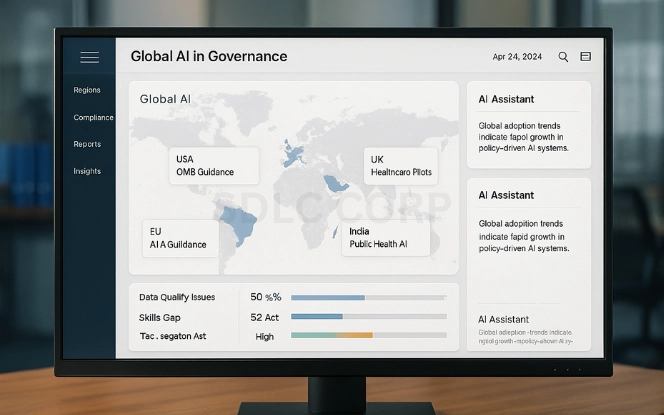
While the U.S. has issued executive orders and OMB guidance on AI, other regions are advancing too.
- European Union: The EU AI Act is setting global standards for risk-based governance.
- United Kingdom: Regulatory agencies are piloting AI oversight in healthcare and justice.
- India: Exploring AI to improve citizen identification, welfare, and public health access.
Each example highlights how Generative AI in Government must be tailored to local laws, resources, and citizen expectations.
Ongoing Development and Technical Oversight
Government systems evolve with policy changes, new regulations, and public needs. Generative AI systems must be updated accordingly. Some agencies choose to hire generative AI developers to maintain models, update integrations, and ensure systems continue to align with governance standards and service requirements.
Conclusion
Generative AI is not a distant promise; it is already shaping how governments operate. The Benefits of Generative AI for Government Services are evident in cost savings, transparency, and inclusivity. But the Challenges of AI Adoption in Government, from data quality to ethical concerns, require careful planning.
Through AI-driven Policy Making and Decision Support, officials can make more informed decisions. When combined with ethical frameworks and responsible oversight, Artificial Intelligence in Governance becomes a tool for trust and efficiency rather than risk.
Governments that balance innovation with accountability will set the standard for the future. If you want to learn how to apply these principles in practice, contact us SDLC Corp.
To take the next step, Hire AI Development Services with SDLC Corp and explore how tailored solutions can transform your organization.
Read Related Blogs:
FAQs
What Are The Benefits Of Generative AI For Government Services?
Generative AI helps governments improve service delivery, reduce administrative delays, and make interactions with citizens more efficient. It can draft official documents, summarize complex data, and generate multilingual responses, making services more inclusive. The Benefits of Generative AI for Government Services also include cost efficiency, transparency in public communication, and evidence-based planning. By automating repetitive processes, agencies save time and resources while focusing on critical decision-making. Overall, these advantages help governments create faster, clearer, and more citizen-friendly services.
How Can Generative AI Support Policy Making And Decision Support In Government?
Generative AI can analyze large datasets and generate insights that support informed choices. In AI-driven Policy Making and Decision Support, it provides simulations of potential policy outcomes, highlights risks, and presents best practices from around the world. For example, AI models can estimate the impact of healthcare reforms, climate policies, or tax regulations before implementation. This does not replace human judgment but provides decision makers with strong data-backed recommendations. By speeding up analysis and offering evidence-based insights, generative AI helps governments design more effective and balanced policies.
What Are The Main Challenges Of AI Adoption In Government Agencies?
The Challenges of AI Adoption in Government include poor data quality, lack of skilled staff, and budget limitations. Agencies may also face resistance to change due to traditional bureaucratic processes. Ethical concerns are another barrier, as biased or opaque AI models can create distrust among citizens. In addition, ensuring compliance with privacy laws and security standards can slow adoption. Overcoming these challenges requires careful planning, workforce training, and strong governance frameworks. When these obstacles are addressed, governments can responsibly use generative AI to transform services and decision-making.
How Does Artificial Intelligence In Governance Ensure Transparency And Trust?
Artificial Intelligence in Governance promotes transparency by generating reports and summaries that citizens can easily understand. Trust comes from using AI responsibly, with clear oversight and accountability. Governments can ensure transparency by making algorithms explainable, publishing impact assessments, and involving human review in all critical decisions. Fairness and privacy protections also play an important role. Citizens are more likely to trust AI if they know their data is secure and decisions are not biased. By combining responsible practices with open communication, governments can strengthen trust in AI-enabled governance.
What Are The Best Practices For Implementing Generative AI In The Public Sector?
Successful implementation of AI for Public Sector services requires a structured approach. Governments should begin with a readiness assessment, focusing on data quality, infrastructure, and legal frameworks. Starting small with pilot projects allows agencies to test AI systems in real-world scenarios. Establishing governance frameworks, including oversight committees, privacy safeguards, and bias audits, is essential. Training staff and building cross-agency collaboration also help adoption. Finally, scaling AI responsibly ensures long-term sustainability. Following these best practices helps governments integrate generative AI while maintaining trust, accountability, and efficiency.

